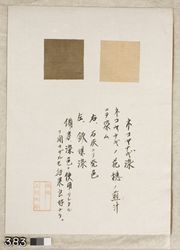Difference between revisions of "Willow bark"
Jump to navigation
Jump to search
| Line 4: | Line 4: | ||
Bark from willow trees (''Salix'') found throughout the world. The bark and watery sap from willow trees has been used for medicinal purposes by the Greeks since the 5th century since extracts produce salicylic acid, the presursor of aspirin. Additionally the flexible shoots and bark were used for weaving and musical instruments. Extracts of the bark produce a pale brown to rose-tan color on wool using an alum mordant. Willow bark dye has good washfastness and fair lightfastness. Willow bark also contains a natural catechol tanning agent used to prepared leather. | Bark from willow trees (''Salix'') found throughout the world. The bark and watery sap from willow trees has been used for medicinal purposes by the Greeks since the 5th century since extracts produce salicylic acid, the presursor of aspirin. Additionally the flexible shoots and bark were used for weaving and musical instruments. Extracts of the bark produce a pale brown to rose-tan color on wool using an alum mordant. Willow bark dye has good washfastness and fair lightfastness. Willow bark also contains a natural catechol tanning agent used to prepared leather. | ||
| − | * For willow dyes, see [[ | + | * For willow dyes, see [[https://cameo.mfa.org/wiki/Category:Uemura_dye_archive '''Uemera Dye Archive''' (Yanagi and Nekoyanagi)]] |
[[File:Uemura 10-15-2009 383.jpg|thumb|Silk dyed with pussy willow flowers, Uemera Dye Archive]] | [[File:Uemura 10-15-2009 383.jpg|thumb|Silk dyed with pussy willow flowers, Uemera Dye Archive]] | ||
Revision as of 11:54, 22 June 2022
Description
Bark from willow trees (Salix) found throughout the world. The bark and watery sap from willow trees has been used for medicinal purposes by the Greeks since the 5th century since extracts produce salicylic acid, the presursor of aspirin. Additionally the flexible shoots and bark were used for weaving and musical instruments. Extracts of the bark produce a pale brown to rose-tan color on wool using an alum mordant. Willow bark dye has good washfastness and fair lightfastness. Willow bark also contains a natural catechol tanning agent used to prepared leather.
- For willow dyes, see [Uemera Dye Archive (Yanagi and Nekoyanagi)]
Resources and Citations
- R.J. Adrosko, Natural Dyes in the United States, Smithsonian Institution Press, Washington, DC, 1968
- John and Margaret Cannon, Dye Plants and Dyeing, Herbert Press, London, 1994
- Wikipedia: https://en.wikipedia.org/wiki/Willow (accessed August 2020)

